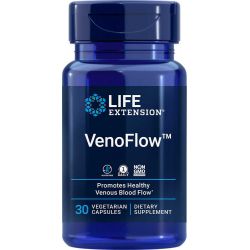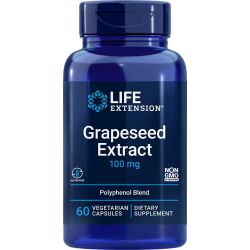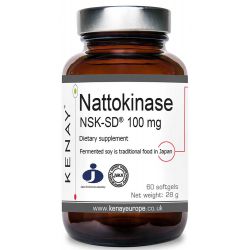Lethal Dangers of Sitting Too Long
 Sitting at a desk or watching TV for too long, without moving your muscles, increases risk of death from a deep-vein clot in the leg by 48%.1
Sitting at a desk or watching TV for too long, without moving your muscles, increases risk of death from a deep-vein clot in the leg by 48%.1
These clots, called deep vein thrombosis (DVT), can result in a pulmonary embolism, an often fatal condition.2,3
Realizing a new strategy is needed in today’s age of sedentary lifestyles, scientists have investigated the effects of various nutrient compounds.
Two extracts—nattokinase and French maritime pine bark—have been found to help prevent the formation of deadly clots, and to make clots that do develop more likely to resolve quickly.4-10
This is an important life-saving finding for anyone who regularly sits for extended periods of time during their daily commute, at their job, on an airplane, or at home watching television.
WHAT YOU NEED TO KNOW
 Spending long periods sitting can lead to deep vein thrombosis, which can trigger a deadly pulmonary embolism.
Spending long periods sitting can lead to deep vein thrombosis, which can trigger a deadly pulmonary embolism.- Nattokinase and French maritime pine bark extract help prevent deep vein thrombosis by inhibiting unhealthy clotting, promoting leg microcirculation, and supporting vein flexibility.
- A human study has shown that this dual-extract blend safely prevented deep vein thrombosis while also decreasing leg swelling.
- These two extracts represent a safe, effective option for preventing the potentially deadly dangers associated with sitting for long periods of time.
A Solution to Deadly Clots
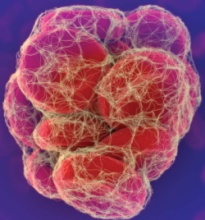 With age and inactivity, blood tends to pool in the legs, and the body’s natural systems that break down clots lose their ability to keep pace with the systems that form clots.13,14
With age and inactivity, blood tends to pool in the legs, and the body’s natural systems that break down clots lose their ability to keep pace with the systems that form clots.13,14
Good lifestyle habits—such as exercising, eating a healthy diet, and avoiding smoking—are important elements for risk reduction. For many people, especially those at high risk of blood clots, good habits may not be enough on their own.
Anti-clotting drugs reduce risk of deep vein thrombosis, but they can cause internal (blood vessel) bleeding.15,16 Compression stockings have shown limited effectiveness17,18 in addition to being uncomfortable in warm weather.
Nattokinase and French maritime pine bark are plant extracts that have been shown to help prevent deep vein thrombosis. The mechanisms include:6-10,19-21
- Inhibiting unwanted clot formation within veins,
- Improving microcirculation in the veins of the legs,
- Promoting elasticity of vessel walls, and
- Inducing breakdown of clots.
Let’s examine the individual effects of each of these natural extracts.
The Anti-Clotting Activities of Nattokinase
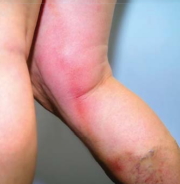
Nattokinase is an enzyme extracted from soybeans fermented with the bacterium Bacillus natto.
Nattokinase directly lowers levels of factors involved in arterial and venous blood clotting.
For example, nattokinase breaks down the main protein found in clots (called fibrin), as well as fibrin’s precursor, fibrinogen.10,19,20
It also reduces the activity of two proteins—factor VIII and factor VII—elevated levels of which can produce unwanted clotting.8
Animal and human studies reveal the effects of these mechanisms of action.
In one study, investigators gave nattokinase to dogs with experimentally induced blood clots. Using a type of X-ray technology, they were surprised to learn that they could literally watch the clots break down in real time.10
In this study, nattokinase produced a mild but steady increase in the rate of fibrin breakdown in the blood, an action that can prevent clots and reduce the size and toughness of existing clots.10
In a later study, scientists demonstrated that nattokinase could break down fibrinogen (fibrin’s precursor) in the blood of spontaneously hypertensive rats. It also reduced blood pressure, a significant finding since high blood pressure is a risk factor for blood clots.22
High blood levels of fibrinogen predispose a person to coronary and cerebral artery disease.23-26 Fibrinogen levels tend to increase with age and poor health habits.27 Life Extension recommends an optimal fibrinogen blood level of 295-369 mg/dL.
Deep Vein Thrombosis: A Silent Killer
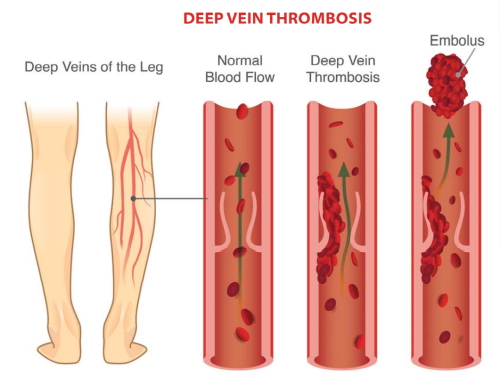 Life Extension® readers take nutrients to reduce arterial plaque and the risk of clot-triggered heart attack or stroke.
Life Extension® readers take nutrients to reduce arterial plaque and the risk of clot-triggered heart attack or stroke.
But even those with healthy arteries can still be at risk for deep vein thrombosis (DVT).
These clots can develop quickly, without warning symptoms, and are often fatal.
When these clots break apart, pieces travel through the circulatory system and can reduce, or entirely block, blood flow to the lungs. This is a pulmonary embolism, which can result in death within minutes.
Up to 100,000 Americans die this way every year.11
Even when it does not result in an embolism, a deep vein thrombosis can lead to post-thrombotic syndrome, a condition characterized by leg pain, heaviness, swelling, scaling, discoloration, or ulceration in the affected limb.11,12
Human Study
A human study corroborates the anti-clotting factors of nattokinase.
For the study, researchers gave 4,000 fibrinolytic units of nattokinase daily, for two months, to three groups of volunteers: healthy individuals, cardiovascular disease patients, and kidney dialysis patients.
All three groups demonstrated significant decreases in pro-coagulation factors VII and VIII, and fibrinogen compared to baseline.8
This study suggests that nattokinase is as effective in individuals with impaired endothelial and coagulation function as it is in those with normal function. There were no adverse effects or unwanted bleeding,8 and other tests confirmed nattokinase’s safety.20
French Maritime Pine Bark Extract
 French maritime pine bark is a natural extract that is rich in special polyphenols.
French maritime pine bark is a natural extract that is rich in special polyphenols.
Studies show that it provides powerful thrombosis-preventive effects by:
- Reducing platelet aggregation, thus inhibiting clots,6
- Increasing the activity of an enzyme that generates nitric oxide, which regulates vascular function to reduce thrombotic risks,21,28
- Scavenging free radicals, which reduces stress on vascular walls that can cause microscopic injuries that trigger coagulation,21
- Improving microcirculation of the legs, which is critical during sedentary periods,7,21 and
- Inhibiting the action of “protein-melting” enzymes, which would otherwise degrade elastic proteins in the blood vessel walls, making them stiff and reducing blood flow.7,29
Putting Pine Bark to the Test
 To validate these effects, scientists enlisted volunteers during flights averaging 8.25 hours. Flying for this duration increases the risk of developing a deep vein thrombosis.
To validate these effects, scientists enlisted volunteers during flights averaging 8.25 hours. Flying for this duration increases the risk of developing a deep vein thrombosis.
The test group took 200 mg of French maritime pine bark extract two to three hours before their flight, another 200 mg six hours into the flight, and another 100 mg the next day. The control group took placebos at the same intervals. All subjects underwent ultrasound scans of their legs within 90 minutes before and after flights to detect clots.4
Incredibly, individuals treated with French maritime pine bark extract showed zero blood clots—a 100% success rate. The controls showed four superficial venous thromboses and one deep venous thrombosis.4 This demonstrates that the extract can prevent blood clots during prolonged periods of sitting.4
In another human trial, subjects who flew for over eight hours twice weekly were divided according to low, moderate, or high risk of thromboses. Within each risk group, some received standard care only, some also received French maritime pine bark extract, and the rest used compression stockings.30
In the moderate- and high-risk groups, those taking bark extract developed zero thromboses. In the moderate-risk group, those receiving standard management showed two thromboses—one deep vein and one superficial vein.30 These unwanted thrombotic results were the same in the high-risk group.
Swelling and ankle circumference were also significantly lower in those taking the extract. No side effects were observed.30
Pine Bark Extract Inhibits Dangerous Lower Leg Swelling
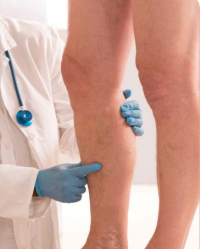 Reduced ankle swelling is an excellent indicator of enhanced return of blood up the legs. For this reason, some scientists have specifically studied ankle swelling as a way to assess the risk of deep vein thrombosis.
Reduced ankle swelling is an excellent indicator of enhanced return of blood up the legs. For this reason, some scientists have specifically studied ankle swelling as a way to assess the risk of deep vein thrombosis.
To assess ankle swelling, researchers enlisted volunteers at risk for deep vein thrombosis due to a long flight. Some received 200 mg of French maritime pine bark extract two to three hours preflight, 200 mg six hours into the flight, and 100 mg the next day. A second group served as controls.
Ankle swelling increased 91% in the control group, but only 36% in the extract group. Similarly, the edema score increased 58.3% in controls, but only 17.9% in the extract group.
The fact that the extract group experienced less swelling confirms its benefit to healthy venous flow,31 a finding that researchers expect can help lead to fewer venous blood clots.
Pine Bark Extract vs. Compression Stockings
 Other studies have compared pine bark extract with compression stockings. Wearing these is a common method for reducing leg swelling, but they are not necessarily effective in reducing post-thrombotic syndrome, which can cause leg pain, heaviness, swelling, scaling, discoloration, or ulceration in the affected limb.11,12
Other studies have compared pine bark extract with compression stockings. Wearing these is a common method for reducing leg swelling, but they are not necessarily effective in reducing post-thrombotic syndrome, which can cause leg pain, heaviness, swelling, scaling, discoloration, or ulceration in the affected limb.11,12
One study showed that taking 150 mg of French maritime pine bark extract daily for 12 months was more effective than stockings in relieving edema, lowering ankle circumference, and enhancing microcirculation.32 More importantly, no deep vein thromboses occurred in the extract group, while the stockings group experienced two episodes.32
In another study, researchers wanted to see how pine bark extract stacked up to compression stockings in people flying twice a week for over eight hours.30 The results showed similar reductions in swelling, with the extract group experiencing a 3.9% reduction, and the stockings group experiencing a 3% reduction, compared to controls.
However, the extract was far superior in reducing post-flight leg pain. Compared to controls, 64.7% fewer extract participants reported post-flight leg pain, while 11.7% more stockings-users reported leg pain.30
Finally, when compared to several compounds believed to reduce swelling, French maritime pine bark extract was found to be superior at reducing edema scores and oxidative stress. It also improved symptom scores comparable to compression stockings.33
Dual-Extract Supplement Prevents Deep Vein Thrombosis
 The above studies demonstrate the individual benefits of nattokinase and French maritime pine bark extract for reducing the factors associated with blood clots and reducing leg pain and swelling.
The above studies demonstrate the individual benefits of nattokinase and French maritime pine bark extract for reducing the factors associated with blood clots and reducing leg pain and swelling.
Next, investigators wanted to determine the combined effects of these two natural compounds.
To do so, they conducted a randomized, placebo-controlled human trial involving 204 passengers on a cross-Atlantic flight. The passengers received either a placebo or a proprietary blend combining nattokinase and French maritime pine bark extract two hours predeparture and again six hours later. Ultrasounds were conducted pre- and post-flight.
Passengers taking the supplement had zero deep vein thrombosis cases—a 100% success rate. In contrast, five control passengers developed a deep vein thrombosis, and two others had superficial clots—a total of seven events.5
And while leg swelling was equal between the two groups preflight, edema decreased by 15% among supplemented passengers, while control passengers experienced a 12% increase. No adverse side effects were reported.5
These findings confirm that these two extracts help prevent deep vein thrombosis and decrease edema in individuals spending long periods sitting—two key steps in reducing the risk of sudden death from a pulmonary embolism.
POSSIBLE SYMPTOMS OF DEEP VEIN THROMBOSIS
Deep vein thrombosis often has no warning signs. But if you do notice any of the following, seek immediate medical attention:34
- Swelling in one or both legs,
- Tenderness or pain in one or both legs, even if it’s only when standing or walking,
- Warm skin on your leg,
- Red or discolored skin on your leg,
- Veins you can suddenly see, and
- Tired legs
Summary
 Deep vein thrombosis is a serious risk for anyone who spends extended periods sitting. In addition to causing uncomfortable leg swelling, it can lead to a sudden and deadly pulmonary embolism.
Deep vein thrombosis is a serious risk for anyone who spends extended periods sitting. In addition to causing uncomfortable leg swelling, it can lead to a sudden and deadly pulmonary embolism.
Nattokinase and French maritime pine bark extract protect against these risks by improving leg microcirculation, promoting vein elasticity, inhibiting venous clot formation, and helping to dissolve any clots that do form.
When taken together, these nutrients have been shown to decrease leg swelling and prevent deep vein thrombosis.
Material used with permission of Life Extension. All rights reserved.
- Stamatakis E, Hamer M, Dunstan DW. Screen-based entertainment time, all-cause mortality, and cardiovascular events: population-based study with ongoing mortality and hospital events follow-up. J Am Coll Cardiol. 2011;57(3):292-9.
- Available at: http://emedicine.medscape.com/article/1911303-overview. Accessed May 22, 2018.
- Available at: http://www.medicinenet.com/deep_vein_thrombosis/article.htm. Accessed May 22, 2018.
- Belcaro G, Cesarone MR, Rohdewald P, et al. Prevention of venous thrombosis and thrombophlebitis in long-haul flights with pycnogenol. Clin Appl Thromb Hemost. 2004;10(4):373-7.
- Cesarone MR, Belcaro G, Nicolaides AN, et al. Prevention of venous thrombosis in long-haul flights with Flite Tabs: the LONFLIT-FLITE randomized, controlled trial. Angiology. 2003;54(5):531-9.
- Golanski J, Muchova J, Golanski R, et al. Does pycnogenol intensify the efficacy of acetylsalicylic acid in the inhibition of platelet function? In vitro experience. Postepy Hig Med Dosw (Online). 2006;60:316-21.
- Grimm T, Schafer A, Hogger P. Antioxidant activity and inhibition of matrix metalloproteinases by metabolites of maritime pine bark extract (pycnogenol). Free Radic Biol Med. 2004;36(6):811-22.
- Hsia CH, Shen MC, Lin JS, et al. Nattokinase decreases plasma levels of fibrinogen, factor VII, and factor VIII in human subjects. Nutr Res. 2009;29(3):190-6.
- Kurosawa Y, Nirengi S, Homma T, et al. A single-dose of oral nattokinase potentiates thrombolysis and anti-coagulation profiles. Sci Rep. 2015;5:11601.
- Sumi H, Hamada H, Nakanishi K, et al. Enhancement of the fibrinolytic activity in plasma by oral administration of nattokinase. Acta Haematol. 1990;84(3):139-43.
- Available at: http://www.cdc.gov/ncbddd/dvt/data.html. Accessed May 22, 2018.
- Vazquez SR, Kahn SR. Postthrombotic Syndrome. Circulation. 2010;121(8):e217-e9.
- Favaloro EJ, Franchini M, Lippi G. Aging hemostasis: changes to laboratory markers of hemostasis as we age - a narrative review. Semin Thromb Hemost. 2014;40(6):621-33.
- Maroney SA, Mast AE. Platelet tissue factor pathway inhibitor modulates intravascular coagulation. Thromb Res. 2012;129 Suppl 2:S21-2.
- Hass B, Pooley J, Harrington AE, et al. Treatment of venous thromboembolism - effects of different therapeutic strategies on bleeding and recurrence rates and considerations for future anticoagulant management. Thromb J. 2012;10(1):24.
- King DA, Pow RE, Dickison DM, et al. Apixaban versus enoxaparin in the prevention of venous thromboembolism following total knee arthroplasty: a single-centre, single-surgeon, retrospective analysis. Intern Med J. 2016;46(9):1030-7.
- Jin YW, Ye H, Li FY, et al. Compression Stockings for Prevention of Postthrombotic Syndrome: A Systematic Review and Meta-Analysis. Vasc Endovascular Surg. 2016;50(5):328-34.
- Skervin AL, Thapar A, Franchini AJ, et al. Systematic Review and Meta-Analysis of Utility of Graduated Compression Stockings in Prevention of Post-Thrombotic Syndrome. Eur J Vasc Endovasc Surg. 2016;51(6):838-45.
- Ero MP, Ng CM, Mihailovski T, et al. A pilot study on the serum pharmacokinetics of nattokinase in humans following a single, oral, daily dose. Altern Ther Health Med. 2013;19(3):16-9.
- Lampe BJ, English JC. Toxicological assessment of nattokinase derived from Bacillus subtilis var. natto. Food Chem Toxicol. 2016;88:87-99.
- Fitzpatrick DF, Bing B, Rohdewald P. Endothelium-dependent vascular effects of Pycnogenol. J Cardiovasc Pharmacol. 1998;32(4):509-15.
- Fujita M, Ohnishi K, Takaoka S, et al. Antihypertensive effects of continuous oral administration of nattokinase and its fragments in spontaneously hypertensive rats. Biol Pharm Bull. 2011;34(11):1696-701.
- Danesh J, Lewington S, Thompson SG, et al. Plasma fibrinogen level and the risk of major cardiovascular diseases and nonvascular mortality: an individual participant meta-analysis. Jama. 2005;294(14):1799-809.
- Wattanakit K, Folsom AR, Chambless LE, et al. Risk factors for cardiovascular event recurrence in the Atherosclerosis Risk in Communities (ARIC) study. Am Heart J. 2005;149(4):606-12.
- Montalescot G, Collet JP, Choussat R, et al. Fibrinogen as a risk factor for coronary heart disease. Eur Heart J. 1998;19 Suppl H:H11-7.
- Stec JJ, Silbershatz H, Tofler GH, et al. Association of Fibrinogen With Cardiovascular Risk Factors and Cardiovascular Disease in the Framingham Offspring Population. Circulation. 2000;102(14):1634-8.
- Associations of Plasma Fibrinogen Levels with Established Cardiovascular Disease Risk Factors, Inflammatory Markers, and Other Characteristics: Individual Participant Meta-Analysis of 154,211 Adults in 31 Prospective StudiesThe Fibrinogen Studies Collaboration. American Journal of Epidemiology. 2007;166(8):867-79.
- Nishioka K, Hidaka T, Nakamura S, et al. Pycnogenol, French maritime pine bark extract, augments endothelium-dependent vasodilation in humans. Hypertens Res. 2007;30(9):775-80.
- Grimm T, Chovanova Z, Muchova J, et al. Inhibition of NF-kappaB activation and MMP-9 secretion by plasma of human volunteers after ingestion of maritime pine bark extract (Pycnogenol). J Inflamm (Lond). 2006;3:1.
- Belcaro G, Cornelli U, Dugall M, et al. Long-haul flights, edema, and thrombotic events: prevention with stockings and Pycnogenol(R) supplementation (LONFLIT Registry Study). Minerva Cardioangiol. 2018;66(2):152-9.
- Cesarone MR, Belcaro G, Rohdewald P, et al. Prevention of edema in long flights with Pycnogenol. Clin Appl Thromb Hemost. 2005;11(3):289-94.
- Errichi BM, Belcaro G, Hosoi M, et al. Prevention of post thrombotic syndrome with Pycnogenol(R) in a twelve month study. Panminerva Med. 2011;53(3 Suppl 1):21-7.
- Belcaro G, Dugall M, Luzzi R, et al. Management of Varicose Veins and Chronic Venous Insufficiency in a Comparative Registry with Nine Venoactive Products in Comparison with Stockings. Int J Angiol. 2017;26(3):170-8.
- Available at: http://www.webmd.com/dvt/deep-vein-thrombosis-dvt-symptoms-diagnosis. Accessed September 22, 2016.

